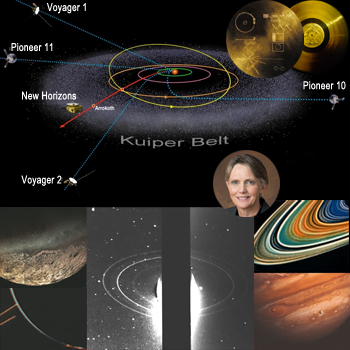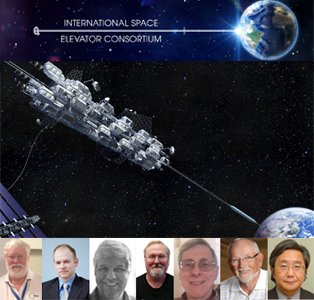Twin Voyagers Reach 45 Years Since Launch, Continue Science in Interstellar Space
|
MONDAY☆ Aug 15 — ISS, ~415-km LEO: Expedition 67 seven-member crew maneuvering Space Station Remote Manipulator System for Dragon CRS-25 undocking procedures; Russia EVA #55 with Artemyev and Matveev to commence this week. ☆ Aug 15 — Tiangong Space Station, ~390-km LEO: Newest TSS module Wentian undergoing integration and testing including new sleeping quarters for Shenzhou 14 three-member crew; Mengtian being readied at Hainan spaceport for October launch. Highlights.. o NewSpace: Momentus working to deploy 3 remaining (out of 10) customer satellites from Vigoride-3 Orbital Transfer Vehicle, targeting Nov for next launch; Weather / earthquake monitoring startup Yunyao Yuhang of Tianjin, China to deploy GNSS-RO / GNSS-R satellite payloads with ~US$14.8M capital; Astra suspending 2022 launches, refocusing efforts on 600kg lift Launch System 2.0. ☆ Solar System: NASA JPL investigating origin of “small hairline object” observed on Mars Perseverance drill; Simulation performed by UC-Riverside researchers indicates Galilean moons are cause of insubstantiality of Jupiter rings; latest Pluto-Charon study from New Horizons indicates endogenic source of volatiles in KBOs may be plausible. ☆ Galaxy: JWST to image AS 209, potentially youngest known planet at 1.6Myr / 395 LY distant from Earth as characterized by ALMA; Harvard / Galileo Project scientists plan recovery mission of interstellar meteorite CNEOS 2014-01-08 submerged in Pacific near Papua New Guinea. o Global: SSLV will soon launch again after “marginal failure”, per former ISRO Chair Kiran Kumar; Rocket Lab CEO Peter Beck confident in 10-15/yr Electron launch cadence, noting “rockets are often ready before the spacecraft”. ● USA: FCC assessing future regulatory framework for Servicing, Assembly, And Manufacturing In Space; Northrop Grumman partnering with Firefly to build domestic Antares 330 powered by 7 Miranda engines; Space X Starship / Super Heavy on track for orbital test flight following successful static firings. ● Hawai’i: Stanford astronomers utilize Keck observatory to study heaviest known Neutron Star / most dense object, ‘Black Widow’ PSR J0952-0607; Gemini North images 90km blue jet / red sprite above thunderstorm. |
 |
● = Terrestrial events, and…
o = International terrestrial events in local time. ★ = Space events, and… ☆ = International space / astro events in Hawaii Standard Time unless noted. Add 10 hours to obtain UT (‘Universal Time’). |
Weekly Planet Watch – Morning Planets: Venus (ENE), Mars (ENE), Jupiter (S), Saturn (SE), Uranus (W), Neptune (S); Evening Planets: Mercury (W).
International Space Elevator Consortium Conference 2022 Considers Space Access Beyond Chemical Propulsion
Running online Aug 19-20 with themes of Dual Space Access Architecture, Materials Science and Engineering, Tether/Climber Interface, Transformational Permanent Space Infrastructure, and Significant Questions to be Answered, ISEC Conference 2022 is to gather leading proponents of sustainable, mechanized entry to space. RP-1 rockets currently emit ~ 1,000 metric tons of carbon, a figure estimated to grow 10x within 2 decades by University College London / Cambridge / MIT study. In contrast to other rocket alternatives such as centrifugal and electromagnetic coil launch, the space elevator concept is appropriate for human travel up to and beyond LEO, and could in theory replace much of the world’s current space infrastructure. ISEC Conference 2022 will feature presentations by ISEC president / Galactic Harbor, Inc Senior VP (L-R) Peter Swan on Space Elevator 101 / Engineering Baseline; Dynamics of a Space Elevator with a GEO station by Vanier College physics professor Stephen Cohen; Economics of Infrastructure for Sustainable Space Access by Phil Swan; and Planetary Defense by Paul Phister. Mini workshops on Tether-Climber Interface and Dual Space Access Architecture to be conducted by ISEC VP Dennis Wright and Director Jerry Eddy. ISEC will also hold an in-person Space Elevator Session at the 73rd International Astronautical Congress in Paris, France on September 19. The Space Elevator event at IAC 2022 will be co-chaired by Peter Swan and Yoji Ishikawa of Obayashi Corporation. (Image Credits: ISEC, ISDC, Obayashi Corporation, ResearchGate) |
● Aug 15-17 — NASA, Online: Live Steam for Artemis I Rollout, Briefings on Science, Tech Payloads; live coverage available. ☆ Aug 15 — Moon: 1.67° SE of Jupiter, 02:00. ☆ Aug 15 — Apollo Asteroid 2021 EW2: Near-Earth Flyby (0.070 AU) ☆ Aug 15 — Aten Asteroid 2017 QC36: Near-Earth Flyby (0.077 AU) Continued From… ★ Jun 28 – Nov 13 — CAPSTONE, Near-Rectilinear Halo Orbit Trajectory: Cislunar Autonomous Positioning System Technology Operations and Navigation Experiment heading to operating position at NRHO / cislunar space. ☆ Aug 4 – Dec 16 — Korea Pathfinder Lunar Orbiter (KPLO), Lunar Trajectory: South Korea ‘Danuri’ to search for lunar resources, test technologies using Ballistic Lunar Transfer, 3 highly elliptical Earth orbits to initiate a trans-lunar injection and arrive at 100-km lunar orbit. TUESDAY● Aug 16 — Maryland Space Business Roundtable (MSBR), Greenbelt MD: MSBR luncheon with Dr. Christyl Johnson, Deputy Director for Technology and Research at NASA Goddard Space Flight Center; 11:30-13:30. ● Aug 16 — Space Foundation, Online / Colorado Springs CO: Symposium 365 Seminar: Start Here for Space / Canadian Space Agency; 13:00-13:30. ● Aug 16 — Lunar and Planetary Institute, USRA, NASA, Online / Houston TX: Abstracts Due: Apollo 17-Apollo Next Generation Sample Analysis Workshop: A Model for Future Exploration of the Moon; being held Oct 26-28. ☆ Aug 16 — Apollo Asteroid 2022 PW: Near-Earth Flyby (0.003 AU) WEDNESDAY☆ Aug 17 — ISS, Russia EVA #55, ~405-km Altitude: Roscosmos Cosmonauts Oleg Artemyev and Denis Matveev to exit International Space Station through Poisk airlock to install cameras and switch to grapple mode on European Robotic Arm to prepare it for relocation to Poisk; live coverage available, starts 9:20 EDT. |
☆ Aug 17 — Venus: 0.64° S of Beehive Cluster, 15:00.
☆ Aug 17 — Apollo Asteroid 2012 QV2: Near-Earth Flyby (0.044 AU)
☆ Aug 17 — Apollo Asteroid 2015 FN35: Near-Earth Flyby (0.054 AU)
☆ Aug 17 — Apollo Asteroid 2022 OR: Near-Earth Flyby (0.089 AU)
☆ Aug 17 — Apollo Asteroid 2021 DC1: Near-Earth Flyby (0.092 AU)
THURSDAY
☆ Aug 18 — ISS, Dragon CRS-25 Undocking / Return to Earth, ~415-km LEO: Dragon cargo ship set to departure ISS and return to Earth with experiments and cargo; undocking scheduled 11:05 EDT, live coverage available.
● Aug 18 — JPL, Caltech, NASA, Online / Pasadena CA: Webinar: Voyager – 45 Years in Space; by Suzanne Dodd, Voyager Project Manager at JPL, 19:00.
☆ Aug 18 — Moon: 0.64° NNE of Uranus, 05:00; at last quarter, 18:35.
☆ Aug 18 — Aten Asteroid 2022 PC: Near-Earth Flyby (0.042 AU)
☆ Aug 18 — Aten Asteroid 2021 RZ3: Near-Earth Flyby (0.067 AU)
FRIDAY
● Aug 19-20 — International Space Elevator Consortium, Online: International Space Elevator Consortium Conference 2022.
☆ Aug 19 — Moon: 2.57° NNW of Mars, 01:00; 2.90° SE of Pleiades, 04:00; 7.4° N of Aldebaran, 22:00.
☆ Aug 19 — Apollo Asteroid 2019 AV13: Near-Earth Flyby (0.049 AU)
SATURDAY
★ Aug 20 — Voyager 2, Interstellar Space: NASA spacecraft begins 46th year / reaches 45 full years in space today, launched Aug 20, 1977 – seventeen days before Voyager 1; expected to send data to Earth until ~2025 when power may run out.
● Aug 20 — AIAA LA-LV Section, Hybrid / Lawndale CA and Online: Making Space for Women Event; 09:30-13:00.
☆ Aug 20 — Mars: 5.5° SE of the Pleiades, 16:00.
☆ Aug 20 — Apollo Asteroid 2019 AV13: Near-Earth Flyby (0.035 AU)
SUNDAY
● Aug 21 — The Space Show, Online / Tiburon CA: Dr. David Livingston talks with Holly Melear of STEAMSPACE.
☆ Aug 21 — Moon: 2.69° N of M35 cluster, 20:00.
☆ Aug 21 — Asteroid 4 Vesta: At opposition in longitude, magnitude 5.8; 21:00.

